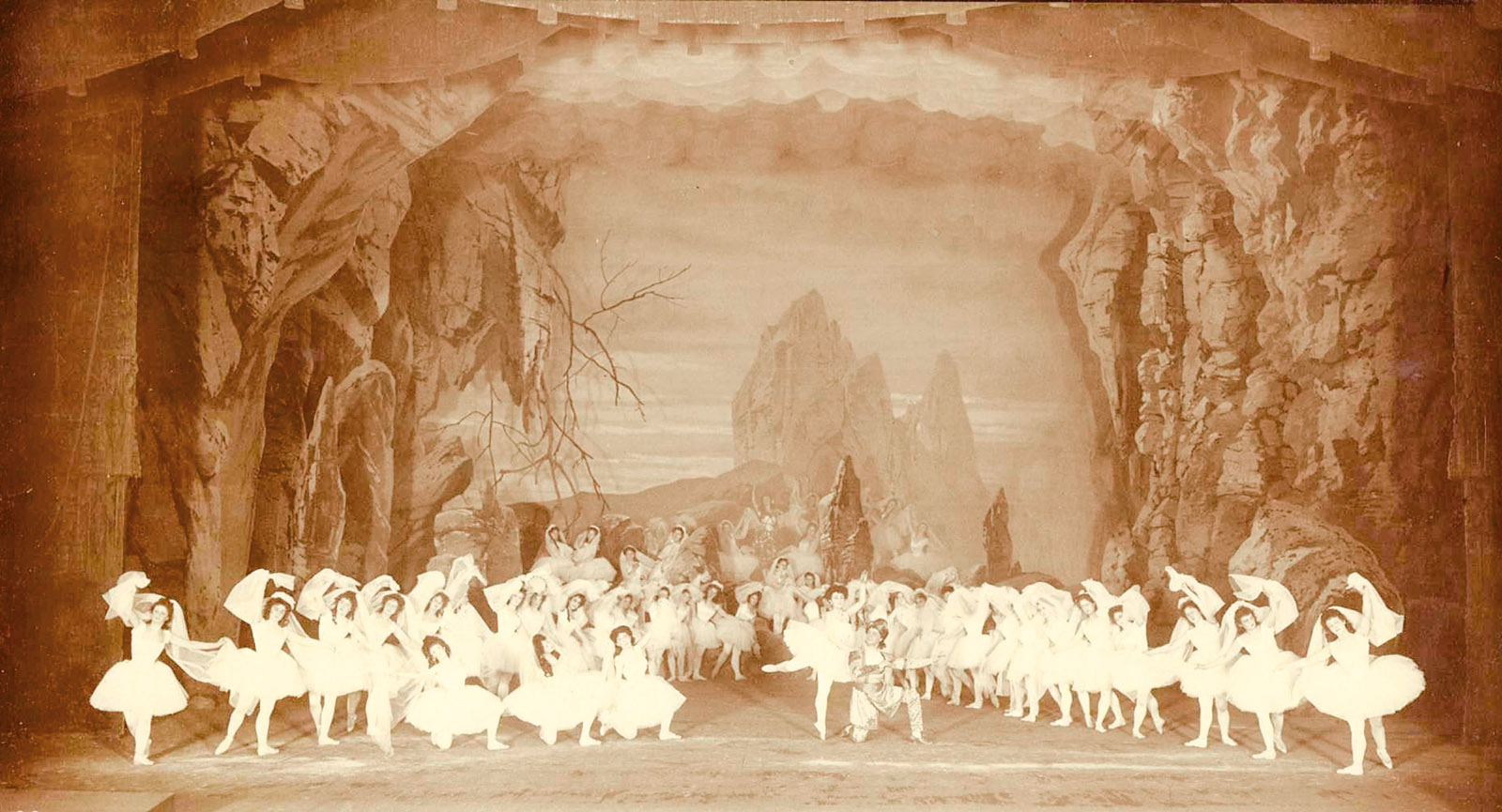
St. Petersburg Museum of Theater and Music
A scene in the Kingdom of the Shades from La Bayadère, 1900; from Marius Petipa: La Dansomanie, a two-volume album in three languages published last year by the St. Petersburg Museum of Theater and Music to celebrate the two hundredth anniversary of Petipa’s birth
It will surprise many people, but not many dance historians, that the most productive and influential ballet choreographer of the late nineteenth century, the Franco-Russian Marius Petipa (1818–1910), was accorded no biography for more than a century after his death. Dance was central to the religious and patriotic festivals of ancient Greece and Rome, but with the transfer of power to the Christian church, it was pretty much kicked out of the arts. It was too closely associated with bodily pleasure. Social dance probably never died out among common folk. As for the better-placed folk, the processions in which the servants of the French and Italian courts of the Renaissance brought dinner to their guests involved, if not exactly dancing, then a great deal of synchronized gown-swishing and foot-pointing. But dance did not officially reenter the lists of the high arts in the West until the seventeenth century, under Louis XIV. Louis imported music masters and dance masters, mostly from Italy, to create elaborate allegorical ballets, in which he himself appeared. In 1661, he founded Europe’s first proper dance school, the Académie Royale de la Danse.
In those days, dance people, like most other theater people, tended to come in families, including actors and musicians as well, because not all of them had a royal academy to teach them their arts. They learned from their mothers and fathers. Also, there was still a stigma attached to making one’s living on the stage (Molière, famously, was denied a Christian burial), so theatrical professionals often married within their own ranks and thereby created clans.
One was the Petipas of France and Belgium. Their name starts appearing in the annals of the Continental theater at the beginning of the nineteenth century. Marius Petipa was the son of a ballet master (that is, a teacher/choreographer) and an actress; most of his siblings too were theater people. In the beginning, he was not the star of the family. That was his older brother, Lucien, a handsomer man and a far better technician. Lucien was the premier classicist of the Paris Opera Ballet, the oldest and most respected company in Europe. (It was the descendant of Louis XIV’s academy.) He was in demand all the way to Russia, but when Russia called, it is said, Lucien, already in possession of a good job, declined, and recommended his younger brother. Thus, in 1847, Marius Petipa, age twenty-nine, presented himself at St. Petersburg’s Imperial Ballet and was given a one-year, let’s-see contract. As it turned out, he stayed for sixty-three years and was the company’s artistic director—or first ballet master, as they called it—for nearly thirty-five years. In Russia he created more than fifty original ballets, mounted versions of nineteen other ballets, and fashioned dances for thirty-seven operas. Today, the name of Lucien is known only to specialists, whereas Marius is acknowledged as the prime creator of late-nineteenth-century ballet and, one could say, the foremost source of twentieth-century ballet as well.
Still, this did not earn him a proper biography—in any language, not just English—until last spring, with the publication of Marius Petipa: The Emperor’s Ballet Master by Nadine Meisner, a longtime dance critic in London.
This Issue
December 19, 2019
No More Nice Dems
What Were Dinosaurs For?
The Master’s Master
-
1
A second Petipa biography, by the musicologist Roland John Wiley, author of Tchaikovsky’s Ballets (1985) and The Life and Ballets of Lev Ivanov (1997), is also in progress. Meisner repeatedly acknowledges Wiley’s work. ↩
-
2
It was originally the Imperial Ballet in St. Petersburg. After the October Revolution of 1917, the name was changed to the State Maryinsky Theater and then to the State Academic Theater for Opera and Ballet. In 1935 the company was renamed the Kirov Ballet, after Sergei Kirov, the head of the Leningrad Communist Party, who had been assassinated in 1934. Finally, in 1991, it reverted to its former name, the Maryinsky Ballet. ↩
-
3
According to Tim Scholl in his From Petipa to Balanchine (1994), Petipa reduced the number to thirty-two in 1887, when his company moved into its new theater, the Maryinsky, which had a shallower stage. Other choreographers, Russian and Western, have pared the ensemble down further. The Royal Ballet has twenty-four shades, as does American Ballet Theatre. One would give a great deal to see the original sixty-four. ↩
-
4
Ivanov also choreographed both the famous lakeside scenes in Swan Lake, now called acts 2 and 4. As for The Nutcracker, it is not clear that Petipa gave Ivanov the entire job of making the dances. His colleague Alexander Shiriaev claimed that Petipa left for Ivanov the dances that he himself didn’t want to work on. The truth may lie between. But the choreography was credited to Ivanov in the program. ↩
-
5
The only English-language edition of the diary is The Diaries of Marius Petipa, edited, translated from the French, and with an introduction by Lynn Garafola, Studies in Dance History, Vol. 3, No. 1 (Spring 1992). Meisner’s chronology of Petipa’s ballets, the most complete now in print in English, is based on Garafola’s. ↩





